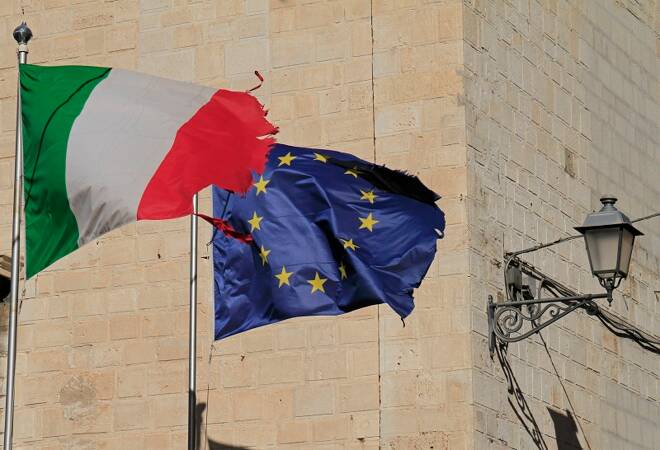Advertisement
Advertisement
Italeave? Political Crisis Causes Havoc in the Italian Bond Market
By:
The tension that’s been gathering in Italy finally erupted last week as coalition talks stalled and a snap election seemed increasingly likely. Investor confidence plummeted, not only in Italy but in the security of the eurozone and the wider economic community as fears intensified over the possibility of an Italian exit from the EU. Order was somewhat restored towards the end of the week when a statement was released late on Thursday that the coalition would be sworn into power the next day. FXTM Senior Writer Kirsty MacSween attempts to make sense of the chaos.
This latest political crisis has been a while in the making. A general election in March did not result in a clear leader but confirmed surging support for nationalist parties. The anti-establishment Five Star Movement (M5S) and the far-right League, who together took more than 50 percent of the vote, have been attempting to form a coalition government based on their shared protectionist policies.
Italian president Sergio Mattarella has the power to veto appointments. Mattarella rejected the nascent coalition’s choice of a noted Eurosceptic for finance minister – Paolo Savona. This refusal prompted the coalition’s choice of prime minister, Giuseppe Conte, to step down. Mattarella appointed an interim prime minister, Carlo Cottarelli, but the resulting backlash was so powerful it looked unlikely that he would be able to govern effectively or even survive a vote of no confidence. There was the talk of another round of elections to follow to try to elect a new government.
The widespread fear was that populist support would solidify and grow, cementing a solid outright win for one of the populist parties and make Italy’s exit from the euro a firm possibility. In fact, there were concerns that this proposed election would serve as a snap referendum on the euro itself. That Mattarella’s intervention was viewed by many as unpatriotic meddling on behalf of Brussels did nothing to calm the groundswell of anger.
There was certainly enough anger towards Mattarella and his choice of prime minister to risk destabilizing Italy’s place in the eurozone. Luigi Di Maio, the leader of M5S, and Matteo Salvini, leader of the League, encouraged their supporters to peacefully mobilize and demonstrate against the president on the 2nd of June. A poll released last Monday suggests there’s been a five percent increase in vote share for the League since the March election.
The general instability rocked the Italian bond market in particular. Ever-sensitive to political turmoil (despite Italy’s fair share of it, historically), short-term Italian bond prices plummeted and yields saw their largest one-day increase in over 25 years, as panic prompted a massive selloff. 10-year bond yields also leap-frogged recent highs, jumping from 1.8 at the start of the month to a startling 3 percent – a level not seen in four years. These rises in bond yields were a sure sign that investors lost their faith in the security of the asset, as they raced to limit their exposure to the Italian economy and demanded higher returns for the money they’re pumping into it.
This crisis also contaminated nearby countries, with yields on Greece’s 10-year bonds increasing to 4.74 percent and Portugal’s to 2.16 percent. Comparisons to the turmoil of the eurozone debt crisis of 2011 and 2012 were made, but some economic commentators remained convinced that this was more of a short-term blip – provided, of course, that Italy made no further moves to withdraw from the EU. Bond yields stayed a good distance away from the dark days of seven percent during the 2011 and 2012 crisis.
They were proved right. On Thursday, Mattarella approved the proposed cabinet put forward by the coalition, and it was announced that the new government would be sworn in the next day – without a vehement eurosceptic in the finance minister’s seat. Bond yield levels were driven back to more normal levels and settled at roughly the same place they were at the start of the week (before Tuesday’s panic-inducing hike).
The anxiety at play in the Italian bond market may have settled for the time being. However, investors should note that, while Savona was the most forthright voice in the coalition about Italy’s place in the EU and the single currency, anti-EU sentiment in Italy’s new government has not been resolved. It’s likely that the financial markets will remain highly sensitive to the inevitably ongoing political drama in Rome. It seems simmering support for populist politics and nationalist policies will continue to be a major actor on the European stage.
To stay on top of the latest currency news and trade the global markets with an award-winning forex broker, join FXTM.
About the Author
Lukman Otunugaauthor
Lukman Otunuga is a research analyst at FXTM. A keen follower of macroeconomic events, with a strong professional and academic background in finance, Lukman is well versed in the various factors affecting the currency and commodity markets.
Did you find this article useful?
Latest news and analysis
Advertisement
